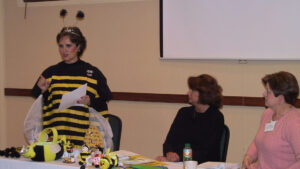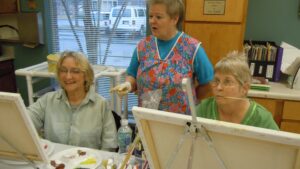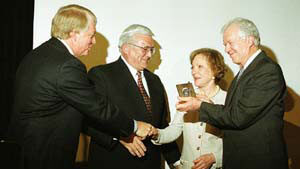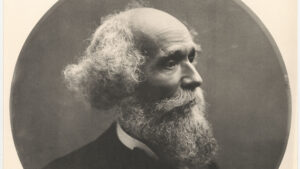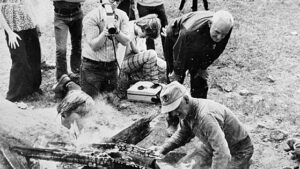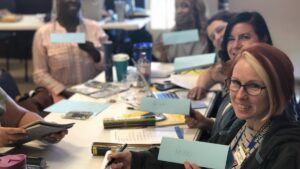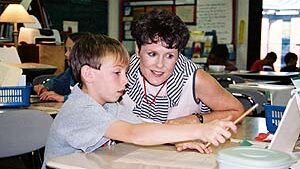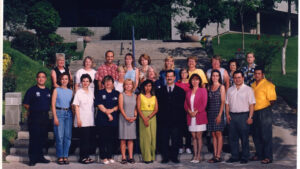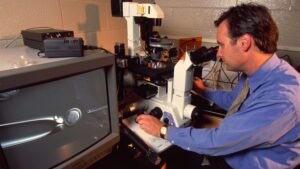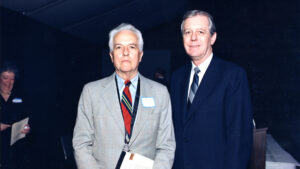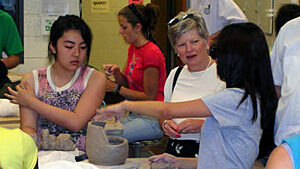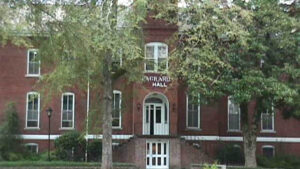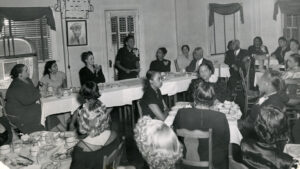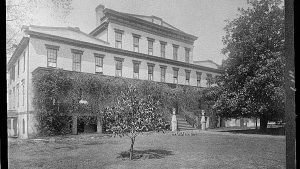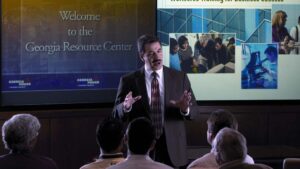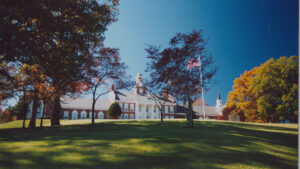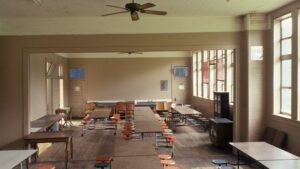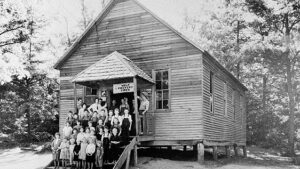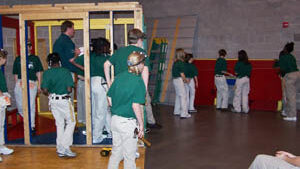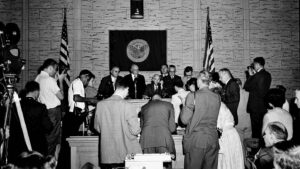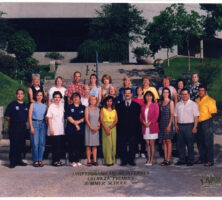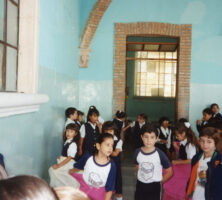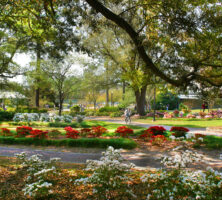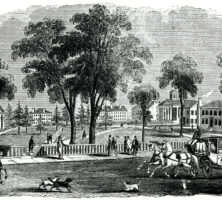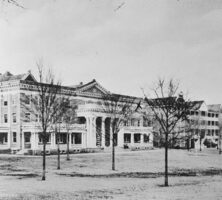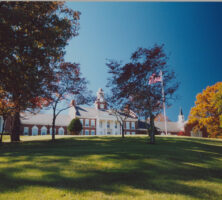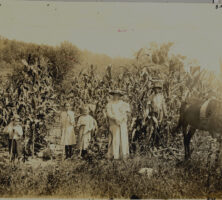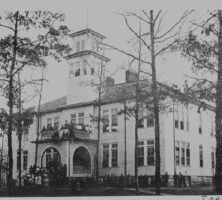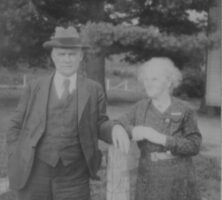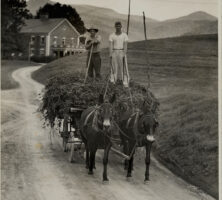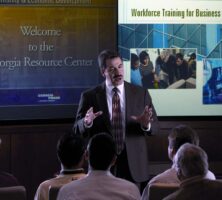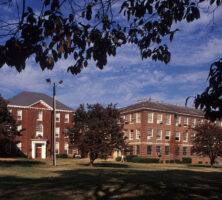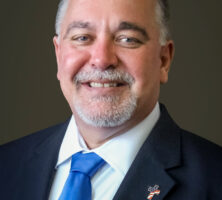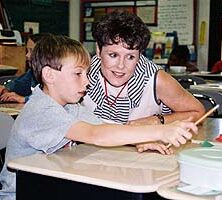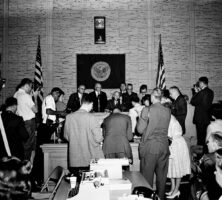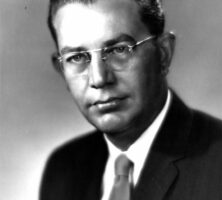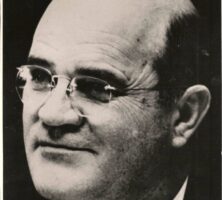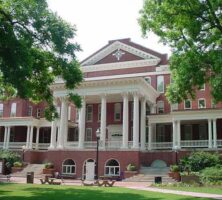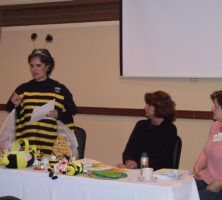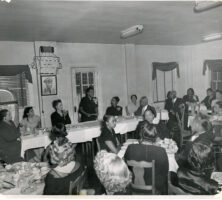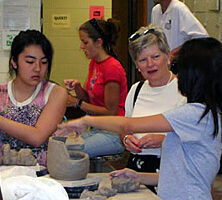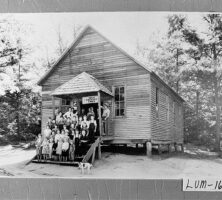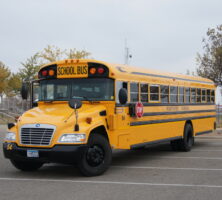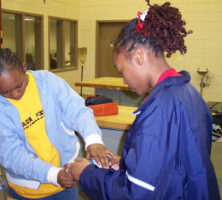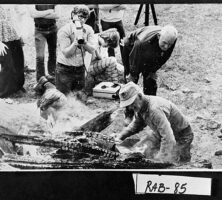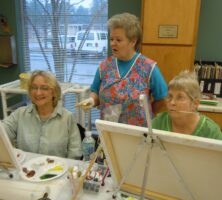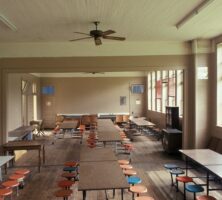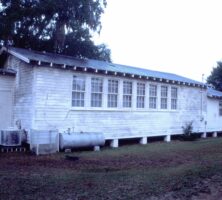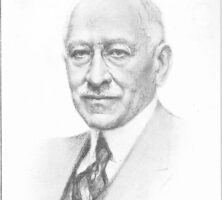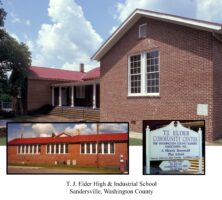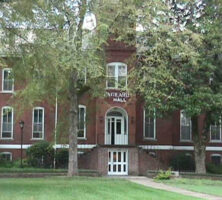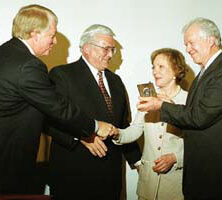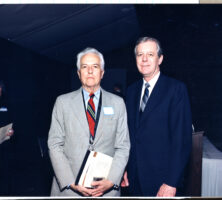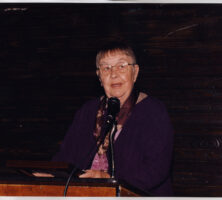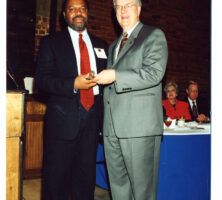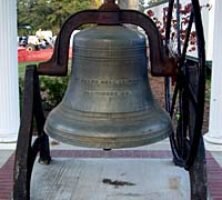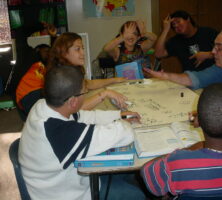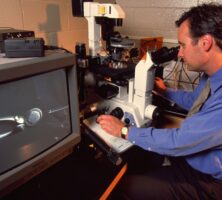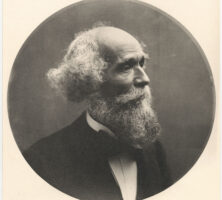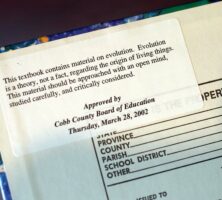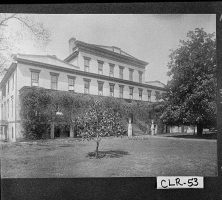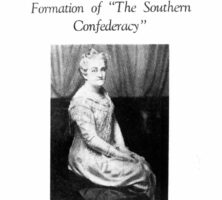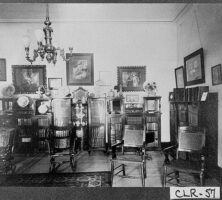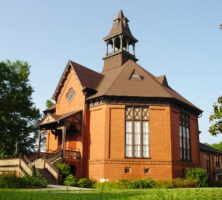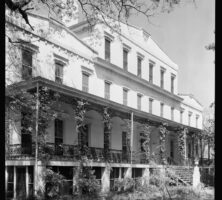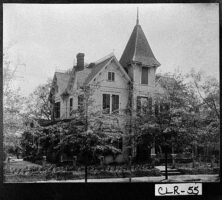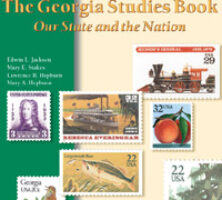The New Georgia Encyclopedia is supported by funding from A More Perfect Union, a special initiative of the National Endowment for the Humanities.
Participants in the Georgia Project attend a summer exchange program in 1998 at the University of Monterrey in Mexico. The Georgia Project was established in 1997 to provide more effective bilingual education to Latino students in the Dalton school system.Reprinted by permission of Erwin Mitchell.
The New Georgia Encyclopedia does not hold the copyright for this media resource and can neither grant nor deny permission to republish or reproduce the image online or in print. Requests for permission to publish or reproduce the resource may need to be submitted to the Richard B. Russell Library for Political Research and Studies at the University of Georgia.
The New Georgia Encyclopedia does not hold the copyright for this media resource and can neither grant nor deny permission to republish or reproduce the image online or in print. All requests for permission to publish or reproduce the resource must be submitted to the rights holder.
Teachers from Dalton visited Monterrey, Mexico, to improve their understanding of Mexican culture and educational practices as part of the Georgia Project, a teacher exchange program founded in Dalton in 1997.Reprinted by permission of Erwin Mitchell.
The New Georgia Encyclopedia does not hold the copyright for this media resource and can neither grant nor deny permission to republish or reproduce the image online or in print. Requests for permission to publish or reproduce the resource may need to be submitted to the Richard B. Russell Library for Political Research and Studies at the University of Georgia.
Erwin Mitchell visits elementary students in 2000 at Roan Street School in Dalton. In 1997 Mitchell founded the Georgia Project, an innovative teacher exchange program that provided training opportunities for Dalton educators working in bilingual classrooms until 2007.Reprinted by permission of Christopher Lancette.
The New Georgia Encyclopedia does not hold the copyright for this media resource and can neither grant nor deny permission to republish or reproduce the image online or in print. Requests for permission to publish or reproduce the resource may need to be submitted to the Richard B. Russell Library for Political Research and Studies at the University of Georgia.
The 634-acre campus of Georgia Southern University in Statesboro features landscaped lawns, pine forests, and two lakes. Walkways wind through the campus and connect the main academic buildings.
Courtesy of Georgia Southern University
The New Georgia Encyclopedia does not hold the copyright for this media resource and can neither grant nor deny permission to republish or reproduce the image online or in print. All requests for permission to publish or reproduce the resource must be submitted to the rights holder.
An early sketch, circa 1850, of the University of Georgia in Athens depicts the Franklin College quadrangle as seen from the southwest across Broad Street. The architecture of the campus was modeled after that of Yale University in Connecticut, the alma mater of Abraham Baldwin, UGA's first president.
The New Georgia Encyclopedia does not hold the copyright for this media resource and can neither grant nor deny permission to republish or reproduce the image online or in print. Requests for permission to publish or reproduce the resource should be submitted to the Hargrett Manuscript and Rare Book Library at the University of Georgia.
The New Georgia Encyclopedia does not hold the copyright for this media resource and can neither grant nor deny permission to republish or reproduce the image online or in print. All requests for permission to publish or reproduce the resource must be submitted to the rights holder.
Georgia Normal and Industrial College in Milledgeville, circa 1913. The college, known today as Georgia College and State University, was founded in 1889. The campus employs a quadrangle design on land originally used for a state prison.
Courtesy of Georgia Archives, Vanishing Georgia, #bal001.
The New Georgia Encyclopedia does not hold the copyright for this media resource and can neither grant nor deny permission to republish or reproduce the image online or in print. Requests for permission to publish or reproduce the resource should be submitted to the Georgia Archives.
Spelman Seminary in Atlanta, pictured circa 1912-13, was founded in 1881 and became Spelman College in 1924. Five years later, the Atlanta University Center formed, joining the school with other African American institutions in the city.
Courtesy of Georgia Archives, Vanishing Georgia, # ful0992c-86.
The New Georgia Encyclopedia does not hold the copyright for this media resource and can neither grant nor deny permission to republish or reproduce the image online or in print. Requests for permission to publish or reproduce the resource should be submitted to the Georgia Archives.
Located in Rabun County, in north Georgia, the Rabun Gap-Nacoochee School is one of the largest college-preparatory boarding schools in the South.
Courtesy of Rabun Gap-Nacoochee School
The New Georgia Encyclopedia does not hold the copyright for this media resource and can neither grant nor deny permission to republish or reproduce the image online or in print. All requests for permission to publish or reproduce the resource must be submitted to the rights holder.
Just after World War I (1917-18) the Rabun Gap school created the Farm Family Settlement Program. Entire families lived at Rabun Gap; the men learned agriculture, the women learned homemaking and health care, and the children attended school. The Speed family is pictured.
Courtesy of Rabun Gap-Nacoochee School
The New Georgia Encyclopedia does not hold the copyright for this media resource and can neither grant nor deny permission to republish or reproduce the image online or in print. All requests for permission to publish or reproduce the resource must be submitted to the rights holder.
Rabun Gap Industrial School students gather for a photograph outside the school's first building circa 1910. The building was designed by Atlanta architect Haralson Bleckley (son of Rabun County native and judge Logan Bleckley).
Courtesy of Georgia Archives, Vanishing Georgia, #
rab107.
The New Georgia Encyclopedia does not hold the copyright for this media resource and can neither grant nor deny permission to republish or reproduce the image online or in print. Requests for permission to publish or reproduce the resource should be submitted to the Georgia Archives.
Andrew Jackson Ritchie and his wife, Addie Corn Ritchie, founded the Rabun Gap Industrial School in 1905 to serve poor children in the area.
Courtesy of Rabun Gap-Nacoochee School
The New Georgia Encyclopedia does not hold the copyright for this media resource and can neither grant nor deny permission to republish or reproduce the image online or in print. All requests for permission to publish or reproduce the resource must be submitted to the rights holder.
A couple of Rabun Gap-Nacoochee School students direct a wagon with mules in the late 1920s. The Coit boys' dormitory can be seen in the background.
Courtesy of Rabun Gap-Nacoochee School
The New Georgia Encyclopedia does not hold the copyright for this media resource and can neither grant nor deny permission to republish or reproduce the image online or in print. All requests for permission to publish or reproduce the resource must be submitted to the rights holder.
A representative from Quick Start, a nationally recognized program offering free workforce training to new and exisiting companies in Georgia, makes a presentation to business leaders. Quick Start's services help to attract new investment and job creation in the state.
Courtesy of Quick Start
The New Georgia Encyclopedia does not hold the copyright for this media resource and can neither grant nor deny permission to republish or reproduce the image online or in print. All requests for permission to publish or reproduce the resource must be submitted to the rights holder.
Georgia State University, one of four major research institutions in the state, is located in downtown Atlanta. Along with the Augusta University, Georgia Institute of Technology, and the University of Georgia, GSU boasts a high percentage of HOPE scholarship recipients among its in-state freshmen each year.
Courtesy of Georgia State University
The New Georgia Encyclopedia does not hold the copyright for this media resource and can neither grant nor deny permission to republish or reproduce the image online or in print. All requests for permission to publish or reproduce the resource must be submitted to the rights holder.
Zell Miller, the governor of Georgia from 1991 to 1999, created the HOPE scholarship program, which was implemented in 1993. Miller designed the program with the threefold purpose of improving the quality of education in Georgia's high schools and colleges, encouraging top Georgia students to attend college in the state, and addressing racial and economic disparities in student enrollment at state institutions.
Oil portrait by Thomas V. Nash, Roswell
The New Georgia Encyclopedia does not hold the copyright for this media resource and can neither grant nor deny permission to republish or reproduce the image online or in print. All requests for permission to publish or reproduce the resource must be submitted to the rights holder.
Fort Valley State University, located in Peach County, is one of ten historically Black colleges and universities in the state. Since the advent of the HOPE scholarship program in 1993, enrollment by Georgia students at historically Black schools in other states has decreased.
The New Georgia Encyclopedia does not hold the copyright for this media resource and can neither grant nor deny permission to republish or reproduce the image online or in print. Requests for permission to publish or reproduce the resource may need to be submitted to the Georgia Department of Community Affairs, Historic Preservation Division.
Students in a Camden County public school participate in class. The Georgia Department of Education oversees all public schools in the state, ensuring that federal and state guidelines are met and administering a variety of programs, including the Migrant Education Program and the Georgia Virtual School.
Courtesy John La Boone
The New Georgia Encyclopedia does not hold the copyright for this media resource and can neither grant nor deny permission to republish or reproduce the image online or in print. All requests for permission to publish or reproduce the resource must be submitted to the rights holder.
Richard Woods has served as state school superintendent since 2015.
Courtesy of Georgia Department of Education.
The New Georgia Encyclopedia does not hold the copyright for this media resource and can neither grant nor deny permission to republish or reproduce the image online or in print. Requests for permission to publish or reproduce the resource may need to be submitted to the Georgia Department of Education.
Diane Sandifer, a Georgia Partnership for Excellence in Education board member from Harris County, observes a student's work at Samuel E. Hubbard Elementary School in Monroe County. Hubbard was one of fourteen stops made during the Partnership's 2004 Bus Trip across Georgia.
Courtesy of Georgia Partnership for Excellence in Education
The New Georgia Encyclopedia does not hold the copyright for this media resource and can neither grant nor deny permission to republish or reproduce the image online or in print. All requests for permission to publish or reproduce the resource must be submitted to the rights holder.
The New Georgia Encyclopedia does not hold the copyright for this media resource and can neither grant nor deny permission to republish or reproduce the image online or in print. All requests for permission to publish or reproduce the resource must be submitted to the rights holder.
Reporters gather at Atlanta's city hall on August 30, 1961, the day that the city's schools were officially integrated. The recommendations of the Sibley Commission to the state legislature in 1960 contributed to the desegregation of schools across Georgia.
Courtesy of Special Collections & Archives, Georgia State University Library, Lane Brothers Commercial Photographers Photographic Collection.
The New Georgia Encyclopedia does not hold the copyright for this media resource and can neither grant nor deny permission to republish or reproduce the image online or in print. Requests for permission to publish or reproduce the resource should be submitted to Special Collections and Archives at Georgia State University.
Under Ernest Vandiver's governorship, from 1959 to 1963, the legislature implemented sweeping changes in the segregation policies of Georgia's public schools. The county unit system for nominating officeholders was also revised during his tenure.
The New Georgia Encyclopedia does not hold the copyright for this media resource and can neither grant nor deny permission to republish or reproduce the image online or in print. Requests for permission to publish or reproduce the resource should be submitted to the Hargrett Manuscript and Rare Book Library at the University of Georgia.
Middle school teachers gather at a workshop sponsored by the Georgia Council on Economic Education. Each year the council provides more than 100 workshops to help teachers develop strategies for teaching economics in their classrooms.
Courtesy of Georgia Council on Economic Education
The New Georgia Encyclopedia does not hold the copyright for this media resource and can neither grant nor deny permission to republish or reproduce the image online or in print. All requests for permission to publish or reproduce the resource must be submitted to the rights holder.
Mills B. Lane, chief executive officer of the Citizens and Southern National Bank, founded the Georgia Council on Economic Education in 1972. The council exists to support economic education in the state's elementary and secondary schools.
Courtesy of Georgia Council on Economic Education
The New Georgia Encyclopedia does not hold the copyright for this media resource and can neither grant nor deny permission to republish or reproduce the image online or in print. All requests for permission to publish or reproduce the resource must be submitted to the rights holder.
The Center for Economic Education, housed in Atkinson Hall at Georgia College and State University in Milledgeville, supports economics teachers in the community by assisting with curriculum development and providing instructional materials. It is one of twelve such centers located on university campuses throughout the state.
Courtesy of Georgia Council on Economic Education
The New Georgia Encyclopedia does not hold the copyright for this media resource and can neither grant nor deny permission to republish or reproduce the image online or in print. All requests for permission to publish or reproduce the resource must be submitted to the rights holder.
Debbie Burdette, director of the Troup County Certified Literate Community Program (CLCP), conducts a workshop in 2006 on planning a spelling bee as a fund-raiser for adult literacy. CLCP participants work at the local level to raise funds for literacy providers and distribute information about literacy issues in the community.
Photograph by Sarah E. McKee, New Georgia Encyclopedia
The New Georgia Encyclopedia does not hold the copyright for this media resource and can neither grant nor deny permission to republish or reproduce the image online or in print. All requests for permission to publish or reproduce the resource must be submitted to the rights holder.
The Literacy Alliance of Muscogee County displays clippings, photographs, and informational brochures about their programs at the 2006 Certified Literate Community Programs retreat in Helen. The alliance was awarded status as a Certified Literate Community in 2000.
Photograph by Sarah E. McKee, New Georgia Encyclopedia
The New Georgia Encyclopedia does not hold the copyright for this media resource and can neither grant nor deny permission to republish or reproduce the image online or in print. All requests for permission to publish or reproduce the resource must be submitted to the rights holder.
Jeanes Supervisors gather at the Georgia Jeanes Teachers Annual Dinner in Atlanta, circa 1945. At the head table, from left to right, Kara Jackson (standing), Mella West, Mr. Hooper. Seated at the next table to the right are Mrs. and Dr. Benjamin Mays.
Courtesy of Atlanta University Center, Robert W. Woodruff Library Archives, Southern Education Foundation Records..
The New Georgia Encyclopedia does not hold the copyright for this media resource and can neither grant nor deny permission to republish or reproduce the image online or in print. All requests for permission to publish or reproduce the resource must be submitted to the Atlanta University Center Robert W. Woodruff Library and Archives Research Center.
The New Georgia Encyclopedia does not hold the copyright for this media resource and can neither grant nor deny permission to republish or reproduce the image online or in print. All requests for permission to publish or reproduce the resource must be submitted to the rights holder.
Jeanie Weathersby, the state deputy superintendent of schools for teacher and student support, visits art students in the Governor's Honors Program at Valdosta State University in June 2005.
Courtesy of Georgia Department of Education
The New Georgia Encyclopedia does not hold the copyright for this media resource and can neither grant nor deny permission to republish or reproduce the image online or in print. All requests for permission to publish or reproduce the resource must be submitted to the rights holder.
The New Georgia Encyclopedia does not hold the copyright for this media resource and can neither grant nor deny permission to republish or reproduce the image online or in print. All requests for permission to publish or reproduce the resource must be submitted to the rights holder.
Students gather outside the schoolhouse in Suches, an unincorporated community in Union County, circa 1940. Today the Woody Gap School in Suches is one of the few remaining small, rural community schools in the state.
Courtesy of Georgia Archives, Vanishing Georgia, #
lum016.
The New Georgia Encyclopedia does not hold the copyright for this media resource and can neither grant nor deny permission to republish or reproduce the image online or in print. Requests for permission to publish or reproduce the resource should be submitted to the Georgia Archives.
The length of a child's bus ride to and from school often plays a role in classroom success. Many elementary students in rural settings have a daily bus ride of more than thirty minutes, which exceeds the recommended limit for children of that age and may prevent communication between parents and teachers about the students' progress and needs.
Image from Greg Gjerdingen
The New Georgia Encyclopedia does not hold the copyright for this media resource and can neither grant nor deny permission to republish or reproduce the image online or in print. All requests for permission to publish or reproduce the resource must be submitted to the rights holder.
Students at Hancock Central High School, a rural school in Sparta, label bottles of water as part of a business program launched around 2000. Students create custom labels for bottled water and run all aspects of the business, which generates profits for the school.
Photograph by Tina Behne, Hancock Central High School
The New Georgia Encyclopedia does not hold the copyright for this media resource and can neither grant nor deny permission to republish or reproduce the image online or in print. All requests for permission to publish or reproduce the resource must be submitted to the rights holder.
The New Georgia Encyclopedia does not hold the copyright for this media resource and can neither grant nor deny permission to republish or reproduce the image online or in print. All requests for permission to publish or reproduce the resource must be submitted to the rights holder.
The New Georgia Encyclopedia does not hold the copyright for this media resource and can neither grant nor deny permission to republish or reproduce the image online or in print. All requests for permission to publish or reproduce the resource must be submitted to the rights holder.
Rabun County students film Joseph and Terry Dickerson making pine tar outside of the Foxfire headquarters around 1970. Foxfire began as a magazine in 1967 and continues to document and preserve the traditional lifeways and culture in the Appalachian Mountains.
Courtesy of Georgia Archives, Vanishing Georgia, #
rab085.
The New Georgia Encyclopedia does not hold the copyright for this media resource and can neither grant nor deny permission to republish or reproduce the image online or in print. Requests for permission to publish or reproduce the resource should be submitted to the Georgia Archives.
In 1967 Foxfire Magazine began publication as a student oral history project in Rabun Gap. Named for the bioluminescent lichens that grow on decaying logs, the magazine documents Appalachian Mountain culture.
The New Georgia Encyclopedia does not hold the copyright for this media resource and can neither grant nor deny permission to republish or reproduce the image online or in print. All requests for permission to publish or reproduce the resource must be submitted to the rights holder.
The New Georgia Encyclopedia does not hold the copyright for this media resource and can neither grant nor deny permission to republish or reproduce the image online or in print. All requests for permission to publish or reproduce the resource must be submitted to the rights holder.
The New Georgia Encyclopedia does not hold the copyright for this media resource and can neither grant nor deny permission to republish or reproduce the image online or in print. All requests for permission to publish or reproduce the resource must be submitted to the rights holder.
The New Georgia Encyclopedia does not hold the copyright for this media resource and can neither grant nor deny permission to republish or reproduce the image online or in print. All requests for permission to publish or reproduce the resource must be submitted to the rights holder.
Service learners at West Gordon Elementary School in Valdosta work on a home construction activity. Named "If I Had a Hammer," the lesson teaches students the academic concepts of geometry and architectural design.
Photograph by Ellen Wiley
The New Georgia Encyclopedia does not hold the copyright for this media resource and can neither grant nor deny permission to republish or reproduce the image online or in print. All requests for permission to publish or reproduce the resource must be submitted to the rights holder.
The New Georgia Encyclopedia does not hold the copyright for this media resource and can neither grant nor deny permission to republish or reproduce the image online or in print. All requests for permission to publish or reproduce the resource must be submitted to the rights holder.
Art instruction is just one of the personal enrichment courses offered in the Learning in Retirement organization at Valdosta State University in Valdosta.
Photograph by Judy Baxter
The New Georgia Encyclopedia does not hold the copyright for this media resource and can neither grant nor deny permission to republish or reproduce the image online or in print. All requests for permission to publish or reproduce the resource must be submitted to the rights holder.
Junior Achievement volunteers inspire children to learn the economics of life through free enterprise education. This year, Junior Achievement of Georgia will reach more than 84,000 students statewide.
Courtesy of Junior Achievement
The New Georgia Encyclopedia does not hold the copyright for this media resource and can neither grant nor deny permission to republish or reproduce the image online or in print. All requests for permission to publish or reproduce the resource must be submitted to the rights holder.
This Rosenwald school interior in Paulding County reflects some of the standard design elements, including wooden floors and tall double-hung windows, specified by Community School Plans, published by the Julius Rosenwald Fund in the 1920s.
The New Georgia Encyclopedia does not hold the copyright for this media resource and can neither grant nor deny permission to republish or reproduce the image online or in print. Requests for permission to publish or reproduce the resource may need to be submitted to the Georgia Department of Community Affairs, Historic Preservation Division.
St. Luke's Rosenwald School was built on Sapelo Island in McIntosh County with funds from the Rural School Building Program of the Julius Rosenwald Fund. The program funded school-building projects in Georgia from 1912 to 1932.
The New Georgia Encyclopedia does not hold the copyright for this media resource and can neither grant nor deny permission to republish or reproduce the image online or in print. Requests for permission to publish or reproduce the resource may need to be submitted to the Georgia Department of Community Affairs, Historic Preservation Division.
In 1912 Julius Rosenwald, a wealthy Illinois philanthropist, donated an initial $25,000 to Tuskegee Institute in Alabama for the construction of schools that would provide a vocational education to Black students. By 1932 the Julius Rosenwald Fund had donated additional funds that were used to build 4,977 school buildings throughout the South.
From Julius Rosenwald Fund: Review of Two Decades 1917-1936, by E. R. Embree
The New Georgia Encyclopedia does not hold the copyright for this media resource and can neither grant nor deny permission to republish or reproduce the image online or in print. All requests for permission to publish or reproduce the resource must be submitted to the rights holder.
The New Georgia Encyclopedia does not hold the copyright for this media resource and can neither grant nor deny permission to republish or reproduce the image online or in print. All requests for permission to publish or reproduce the resource must be submitted to the rights holder.
T.J. Elder High and Industrial School in Sandersville is one of the few Rosenwald school buildings known to have survived in Georgia. The Julius Rosenwald Fund supported the construction of 242 vocational schools for African American children in the state from 1912 to 1932.
The New Georgia Encyclopedia does not hold the copyright for this media resource and can neither grant nor deny permission to republish or reproduce the image online or in print. Requests for permission to publish or reproduce the resource may need to be submitted to the Georgia Department of Community Affairs, Historic Preservation Division.
The Historically Black College and Universities Initiative, established in 1980 by U.S. president Jimmy Carter, works to provide grants to historically Black campuses to preserve and protect their historic buildings. Packard Hall at Spelman College was identified as endangered in 1988 by the National Park Service.
Courtesy of Spelman College
The New Georgia Encyclopedia does not hold the copyright for this media resource and can neither grant nor deny permission to republish or reproduce the image online or in print. All requests for permission to publish or reproduce the resource must be submitted to the rights holder.
The New Georgia Encyclopedia does not hold the copyright for this media resource and can neither grant nor deny permission to republish or reproduce the image online or in print. All requests for permission to publish or reproduce the resource must be submitted to the rights holder.
Jimmy and Rosalynn Carter accept the inaugural Delta Prize for Global Understanding in 1999 from Michael F. Adams, president of the University of Georgia, and Maurice Worth, then chief operating officer of Delta. The Carters and the Carter Center were awarded the prize for their efforts to "wage peace" throughout the world.
Photograph by Peter Frey
The New Georgia Encyclopedia does not hold the copyright for this media resource and can neither grant nor deny permission to republish or reproduce the image online or in print. All requests for permission to publish or reproduce the resource must be submitted to the rights holder.
The New Georgia Encyclopedia does not hold the copyright for this media resource and can neither grant nor deny permission to republish or reproduce the image online or in print. All requests for permission to publish or reproduce the resource must be submitted to the rights holder.
The New Georgia Encyclopedia does not hold the copyright for this media resource and can neither grant nor deny permission to republish or reproduce the image online or in print. All requests for permission to publish or reproduce the resource must be submitted to the rights holder.
Vaclav Havel, the first president of the Czech Republic, received the Delta Prize for Global Understanding in 2004. Havel was recognized for his efforts against communist political repression in the 1970s and 1980s, as well as for his leadership in creating a more peaceful Europe.
Image from Jiří Jiroutek
The New Georgia Encyclopedia does not hold the copyright for this media resource and can neither grant nor deny permission to republish or reproduce the image online or in print. All requests for permission to publish or reproduce the resource must be submitted to the rights holder.
Governor Joe Frank Harris (right) with historian Phinizy Spalding, who received a Governor's Award in the Humanities in 1990.
Courtesy of Georgia Humanities.
The New Georgia Encyclopedia does not hold the copyright for this media resource and can neither grant nor deny permission to republish or reproduce the image online or in print. All requests for permission to publish or reproduce the resource must be submitted to Georgia Humanities.
Poet Laureate Bettie Sellers delivers a lecture entitled "Westward from Bald Mountain: Valleys for Writers" at the 1998 awards luncheon for the Governor's Awards in the Humanities. Sellers won a Governor's Award in 1987 and served as the state's poet laureate from 1997 to 2000.
Courtesy of Georgia Humanities.
The New Georgia Encyclopedia does not hold the copyright for this media resource and can neither grant nor deny permission to republish or reproduce the image online or in print. All requests for permission to publish or reproduce the resource must be submitted to Georgia Humanities.
Governor Roy Barnes (right) with Joseph Jordan, accepting the Governor's Award on behalf of the Auburn Avenue Research Library in 2001.
Courtesy of Georgia Humanities.
The New Georgia Encyclopedia does not hold the copyright for this media resource and can neither grant nor deny permission to republish or reproduce the image online or in print. All requests for permission to publish or reproduce the resource must be submitted to Georgia Humanities.
The bell that once rang for the Braselton High School, from 1920 to 1957, now sits on the grounds of Braselton's town hall.
Courtesy of Britney Compton
The New Georgia Encyclopedia does not hold the copyright for this media resource and can neither grant nor deny permission to republish or reproduce the image online or in print. All requests for permission to publish or reproduce the resource must be submitted to the rights holder.
Today, about 1.6 million students are enrolled in Georgia's public schools. A statewide system of public education was first mandated by the Georgia constitution of 1868.
Courtesy of John La Boone
The New Georgia Encyclopedia does not hold the copyright for this media resource and can neither grant nor deny permission to republish or reproduce the image online or in print. All requests for permission to publish or reproduce the resource must be submitted to the rights holder.
Students at the Atlanta Area School for the Deaf participate in a math lesson. The school, in Clarkston, is one of three schools for students with special needs operated by the state.
Courtesy of Atlanta Area School for the Deaf
The New Georgia Encyclopedia does not hold the copyright for this media resource and can neither grant nor deny permission to republish or reproduce the image online or in print. All requests for permission to publish or reproduce the resource must be submitted to the rights holder.
Produced by the University of Georgia College of Education and General Mills, The School That Learned to Eat (1948) is a short film chronicling a community's efforts to improve the school lunch program at East Griffin Elementary School in Spalding County.
The New Georgia Encyclopedia does not hold the copyright for this media resource and can neither grant nor deny permission to republish or reproduce the image online or in print. Requests for permission to publish or reproduce the resource may need to be submitted to the Richard B. Russell Library for Political Research and Studies at the University of Georgia.
An expert in animal cloning, Steven Stice is a Georgia Research Alliance Eminent Scholar at the University of Georgia. The alliance and its university partners work to find those areas of research and development that have the greatest potential for building a technology-rich economy for Georgia.
Courtesy of University of Georgia Photographic Services
The New Georgia Encyclopedia does not hold the copyright for this media resource and can neither grant nor deny permission to republish or reproduce the image online or in print. All requests for permission to publish or reproduce the resource must be submitted to the rights holder.
The Caterpillar company's Hydraulic Hammer is an example of a successful collaborative effort between a Georgia business and a Technology Transfer program of the Georgia Research Alliance.
Image from Virgina Department of Transportation
The New Georgia Encyclopedia does not hold the copyright for this media resource and can neither grant nor deny permission to republish or reproduce the image online or in print. All requests for permission to publish or reproduce the resource must be submitted to the rights holder.
Geology professor and member of a prominent Georgia family, Joseph LeConte was a well-known proponent of evolution, and his book Evolution and Its Relation to Religious Thought (1888) became one of the most popular works on the subject.
Courtesy of Hargrett Rare Book and Manuscript Library, University of Georgia Libraries, Georgia Photo File.
The New Georgia Encyclopedia does not hold the copyright for this media resource and can neither grant nor deny permission to republish or reproduce the image online or in print. Requests for permission to publish or reproduce the resource should be submitted to the Hargrett Manuscript and Rare Book Library at the University of Georgia.
In 2002 the Cobb County School Board voted to place disclaimers about biological evolution in its biology textbooks and proposed the adoption of a policy stating that "discussion of disputed views of academic subjects is a necessary element of providing a balanced education."
Courtesy of Atlanta Journal-Constitution.
The New Georgia Encyclopedia does not hold the copyright for this media resource and can neither grant nor deny permission to republish or reproduce the image online or in print. All requests for permission to publish or reproduce the resource must be submitted to the Atlanta Journal-Constitution.
The Lucy Cobb Institute, a secondary school for young women in Athens, was founded in 1859 by Thomas R. R. Cobb, a prominent lawyer and proslavery writer.
Courtesy of Georgia Archives, Vanishing Georgia, # clr053.
The New Georgia Encyclopedia does not hold the copyright for this media resource and can neither grant nor deny permission to republish or reproduce the image online or in print. Requests for permission to publish or reproduce the resource should be submitted to the Georgia Archives.
In 1991 the main office of the Carl Vinson Institute of Government moved from the University of Georgia's North Campus to the historic Lucy Cobb Institute building on Milledge Avenue, just west of campus.
Courtesy of Georgia Info, Digital Library of Georgia.
The New Georgia Encyclopedia does not hold the copyright for this media resource and can neither grant nor deny permission to republish or reproduce the image online or in print. Requests for permission to publish or reproduce the resource may need to be submitted to the Digital Library of Georgia.
Mildred Lewis Rutherford, a teacher, historian, writer, and lecturer known primarily for her Confederate memorial activities, published a monthy periodical entitled Miss Rutherford's Scrap Book from 1923 to 1926.
From Miss Rutherford's Scrap Book, vol. 4, April 1923
The New Georgia Encyclopedia does not hold the copyright for this media resource and can neither grant nor deny permission to republish or reproduce the image online or in print. All requests for permission to publish or reproduce the resource must be submitted to the rights holder.
Photograph of the interior of the Lucy Cobb Institute library, circa 1900.
Courtesy of Georgia Archives, Vanishing Georgia, #clr057.
The New Georgia Encyclopedia does not hold the copyright for this media resource and can neither grant nor deny permission to republish or reproduce the image online or in print. Requests for permission to publish or reproduce the resource should be submitted to the Georgia Archives.
The Seney-Stovall Chapel, an octagonal structure built in the 1880s, served as the chapel for the Lucy Cobb Institute, a secondary school for girls in Athens. Restoration of the Victorian chapel, which is listed on the National Register of Historic Places, was completed in 1997.
Courtesy of Georgia Info, Digital Library of Georgia.
The New Georgia Encyclopedia does not hold the copyright for this media resource and can neither grant nor deny permission to republish or reproduce the image online or in print. Requests for permission to publish or reproduce the resource may need to be submitted to the Digital Library of Georgia.
Mildred Lewis Rutherford served as teacher and principal of the Lucy Cobb Institute in Athens for twenty-two years. The students, known as "Lucies," encountered a more academically serious curriculum than was found at the stereotypical finishing school.
Courtesy of Library of Congress, Prints and Photographs Division, Carnegie Survey of the Architecture of the South.
The New Georgia Encyclopedia does not hold the copyright for this media resource and can neither grant nor deny permission to republish or reproduce the image online or in print. All requests for permission to publish or reproduce the resource must be submitted to the rights holder.
The Villa, pictured circa 1900, was located at the corner of Milledge Avenue and Reese Street in Athens. It served as the home of the Lucy Cobb Institute's principal until it burned down in 1927.
Courtesy of Georgia Archives, Vanishing Georgia, #
clr055.
The New Georgia Encyclopedia does not hold the copyright for this media resource and can neither grant nor deny permission to republish or reproduce the image online or in print. Requests for permission to publish or reproduce the resource should be submitted to the Georgia Archives.
Located on the University of Georgia's north campus, the Dean Rusk Center conducts research, presents conferences, promotes teaching, and provides information concerning international and comparative law.
Courtesy of University of Georgia Photographic Services
The New Georgia Encyclopedia does not hold the copyright for this media resource and can neither grant nor deny permission to republish or reproduce the image online or in print. All requests for permission to publish or reproduce the resource must be submitted to the rights holder.
The New Georgia Encyclopedia does not hold the copyright for this media resource and can neither grant nor deny permission to republish or reproduce the image online or in print. All requests for permission to publish or reproduce the resource must be submitted to the rights holder.
In his 1990 gubernatorial campaign, Zell Miller promised to institute a state lottery, with the proceeds going directly to fund new educational programs like the HOPE Scholarship, which offers college scholarships to students who maintain a B average.
Image from U.S. Congress
The New Georgia Encyclopedia does not hold the copyright for this media resource and can neither grant nor deny permission to republish or reproduce the image online or in print. All requests for permission to publish or reproduce the resource must be submitted to the rights holder.
Harris's most visible achievement as governor was a sweeping reform of public education. The program, known as Quality Basic Education, sought to improve funding for Georgia public schools by expanding student testing, introducing new programs for students with disabilities, and increasing teacher salaries.
The New Georgia Encyclopedia does not hold the copyright for this media resource and can neither grant nor deny permission to republish or reproduce the image online or in print. Requests for permission to publish or reproduce the resource should be submitted to the Hargrett Manuscript and Rare Book Library at the University of Georgia.
One of the two textbooks approved by the Georgia Board of Education for use in the public schools is The Georgia Studies Book: Our State and the Nation, by Edwin L. Jackson et al. (Athens: Carl Vinson Institute of Government, University of Georgia, 1998).
Courtesy of Georgia Info, Digital Library of Georgia.
The New Georgia Encyclopedia does not hold the copyright for this media resource and can neither grant nor deny permission to republish or reproduce the image online or in print. Requests for permission to publish or reproduce the resource may need to be submitted to the Digital Library of Georgia.
The New Georgia Encyclopedia does not hold the copyright for this media resource and can neither grant nor deny permission to republish or reproduce the image online or in print. All requests for permission to publish or reproduce the resource must be submitted to the rights holder.
The New Georgia Encyclopedia does not hold the copyright for this media resource and can neither grant nor deny permission to republish or reproduce the image online or in print. All requests for permission to publish or reproduce the resource must be submitted to the rights holder.
The New Georgia Encyclopedia does not hold the copyright for this media resource and can neither grant nor deny permission to republish or reproduce the image online or in print. All requests for permission to publish or reproduce the resource must be submitted to the rights holder.
The New Georgia Encyclopedia does not hold the copyright for this media resource and can neither grant nor deny permission to republish or reproduce the image online or in print. All requests for permission to publish or reproduce the resource must be submitted to the rights holder.

